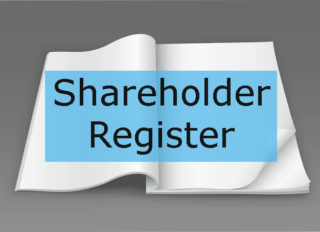Table of Contents

As the name suggests, the shareholder’s register, also commonly referred to as a register of members, serves as one of the numerous statutory company registers providing basic information about who the shareholders of a company are. Under English law, a person cannot formally be considered a shareholder of a company until their name is entered onto this register; this applies even if they possess a share certificate issued by the company. It is therefore crucial that all the relevant information is included and updated regularly to reflect any changes, should it be inspected by a member of the company, third party, or member of the Companies House.
What is a shareholder register?
Shareholders or members of any company are commonly understood to serve as owners limited by shares. For this reason, it is essential that information regarding each of the company’s shareholders are both recorded on an electronic or physical shareholder register book and updated intermittently by either the company itself or an appointed third-party registry service. The contents of the shareholder register itself should detail information regarding who the beneficial owners of the company are, the date each member was registered as a shareholder of the company, the date the member ceased to be a member and other additional details which will be elaborated below.
But why is it so important that this register exists and continues to be maintained over the lifespan of the company? Besides upholding corporate governance principles of accountability and transparency by serving as proof of ownership in the company, the shareholder register becomes an especially pertinent and practical instrument when the company is sold or its shares are transferred to buyers. In such cases, the legal due diligence process will entail looking through all of the company’s registers to confirm who the shareholders are and ensure that sellers are in a position to enter into the deal.
Are shareholder registers public?
Yes, a company’s shareholder register is public and can be accessed by anyone within the company, as well as any interested third parties at any time.
Under Section 116 of the Companies Act, 2006 covering the rights to inspect and require copies of the company’s register, members of the company may access the shareholder register free of charge when necessary, while a fee may be imposed on any other party who wishes to inspect the register. However, it is necessary to note that this section also requires the requesting party to explain the purpose for which the information on the share register is to be used, as well as all other potential parties that the information will be disclosed. In response to such requests, companies have five working days to either grant requests or ask a court to decline the request.
How does a shareholder register work and what information is included?
The shareholder register is divided into sections governing each share class that is issued by the company, which lists all of the relevant shareholders in alphabetical order by last name. Traditionally, all of this information was manually entered into a shareholder register book or binder, however, it is now more common to keep an electronic record of this information.
While the exact contents of each shareholder register vary across the board, the details which must be included within all shareholder registers include:
- the names and physical addresses of each shareholder,
- the date each person was registered as a shareholder,
- the date any person ceased to serve as a shareholder,
- details of the shares held by each shareholder such as its class and number of shares held, and
- the purchase price and payment status of each shareholder’s share.
Moreover, following your first shareholder register entry at the time of incorporation, any changes thereafter should be duly noted and reflected promptly on the register. These updates can include but are not limited to: share transfers to new or existing members, transmissions of shares, and changes to personal details such as the shareholder’s name or address.
If a company member ceases to serve as a shareholder, their name will remain on the shareholder’s register for the following ten years, however, the register should note the date they ceased to be a shareholder. This record is to be kept at the site of the company’s registered office so that such aforementioned details may be altered efficiently, however, the register may alternatively be stored at a different location, formally called the Single Alternative Inspection Location (SAIL), which is disclosed to the Companies House.
Who maintains the shareholder register?
In the UK, the shareholder register, as well as other important statutory registers such as the register of directors, secretaries, and other persons with significant control, must be maintained by the company’s director, secretaries, or third party registry service provider.
Requirements of a shareholder register
As the frequency of changes made to the register depends on a multitude of factors such as the size of the company and number of shareholders, not all changes must be reported to the Companies House immediately. Besides alterations made to share allotments, which are typically filed in the Companies House through separate forms, regular share transfers do not need to be filed immediately and can instead be included when you complete your next annual confirmation statement or annual return statement submitted to the Companies House.
The shareholder register serves as a fundamental document for all companies across jurisdictions, clarifying important information about the make-up and ownership rights of a business. Ensure that your company properly constructs its own shareholder register by consulting Zegal’s wealth of resources and templates below.
READ MORE: Five Clauses Every Shareholders’ Agreement Should Include.
DOCUMENT: Shareholders Agreement
Follow us on Facebook, Linkedin & Twitter





